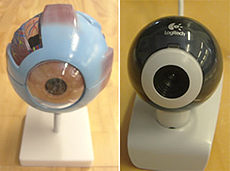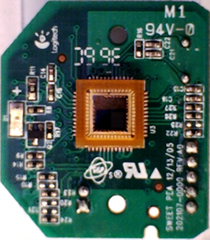Abstract
 Digital cameras are remarkably similar in construction to the human eye. The photos show a dissected webcam and reveal its inner workings and the similarity to the eye.
Digital cameras are remarkably similar in construction to the human eye. The photos show a dissected webcam and reveal its inner workings and the similarity to the eye.
The photo at right shows a model of the human eye and a webcam. The similarity is striking.
Portable
Yes
Principles Illustrated

The construction of a webcam mimics the construction of the human eye. Both are based on the RGB model in which the appearance of an object, particularly its colour, is determined by how much the light from the object stimulates the three kinds of colour detectors that are sensitive primarily to red, green, and blue light. In fact, red, green and blue are the ‘primary’ colours of light only because of the construction of the human eye. More detail about that on the Seeing Colours resource.

We have photographed a web cam in various stages of dis-assembly and have managed to get a photograph through a powerful light microscope of the RGB detectors on the webcam’s ‘retina’, or CCD (charge coupled device). The photograph at right shows the RGB detectors on the “retina.” Note there are twice as many green as red or blue detectors.
Click here for a more detailed discussion.
NCEA & Science Curriculum
JNR SCI
Instructions
You can take a camera apart yourself – but don’t expect it to work properly when reassembled.
Safety
There are many small parts in a webcam, and materials used in electronic circuits are toxic. This is not for younger students. NEVER grind, sand, file, or otherwise damage the circuits themselves as this can liberate toxic materials.
Individual teachers are responsible for safety in their own classes. Even familiar demonstrations should be practised and safety-checked by individual teachers before they are used in a classroom.
Related Resources
- Computer colours
- Seeing colours
- Is it really yellow?
Extensions
Many of our optics demonstrations can be used to help students understand how human vision works.
More broadly, physicists are turning their attention to biological systems and biophysics is now one of the most interesting and most rapidly advancing areas of science.
Teaching Resources
Would you like to contribute lesson suggestions? Contact us.
Credits
Much of the work on this demonstration was completed by a senior high school student working at Victoria University over the summer.
This teaching resource was developed with support from
The MacDiarmid Institute
Faculty of Science, Victoria University of Wellington
School of Chemical and Physical Sciences, Victoria University of Wellington